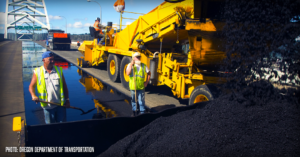Hauling Industry News
The Complete 7-Step Process For Asphalt Pavement Installation
 It’s never too late to learn something new, and when it comes to asphalt pavement installation, there are many things that homeowners, commercial property owners and municipality employees many not be aware of.
It’s never too late to learn something new, and when it comes to asphalt pavement installation, there are many things that homeowners, commercial property owners and municipality employees many not be aware of.
Step 1: Demolition and Removal
The first step in the asphalt installation process is to remove the existing surface, whether it is asphalt, concrete or pavers.
Demolition and removal is completed using heavy machinery, including small bobcats and forklifts and when necessary, front loaders and large dump trucks.
Debris is removed and in most instances, Wolf Paving recycles the old asphalt and concrete in our asphalt plants, turning deteriorating waste into strong, usable new asphalt.
In fact, Wolf Paving typically recycles nearly 100% of the materials removed from a job site, making the choice to use Wolf Paving both green and environmentally friendly.
Step 2: Grading and Sloping
With a clean slate, technology helps Wolf Paving asphalt professionals prepare the surface for appropriate water drainage.
Using laser guided transits and automatic motor graders, the Wolf Paving team grades the surface to be paved to ensure that water will run-off appropriately.
Proper water drainage is vital to your asphalt, because water is a major cause of damage, including potholes, cracks and heaving.
Step 3: Prepare the Sub Base
You’d never guess that the most important part of your new asphalt surface is actually the sub base.
The sub base provides a stable surface to support new pavement.
The sub base is a frost barrier to help reduce winter damage due to freezing and thawing.
During the installation, base thickness, base stability and compaction are important steps. If the sub base is not appropriately compacted, the asphalt surface on top will not provide years of durability.